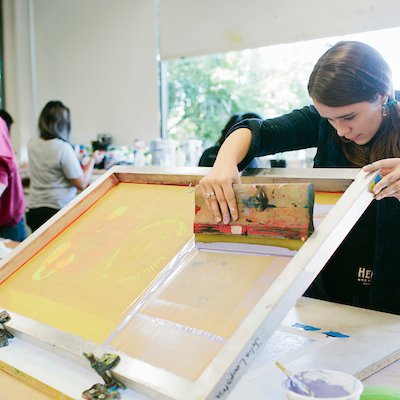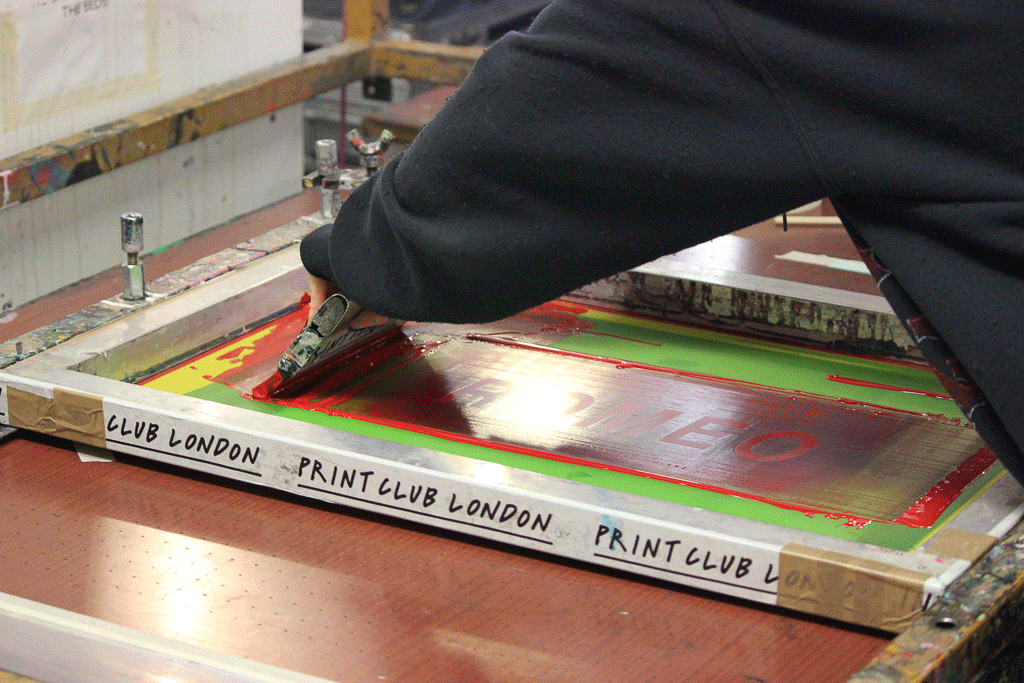ChatGPT said: Why 10:9 Design near me is the most reliable for local customers
Discover the Numerous Sorts Of Screen Printing Techniques for Your Following Project
Screen printing supplies a varied array of techniques that can boost any innovative project. From traditional approaches like serigraphy to contemporary innovations such as direct-to-garment printing, each technique has its one-of-a-kind benefits. Specialty choices, including metal and environment-friendly inks, introduce even much more opportunities. Understanding these strategies can significantly affect the final end result. The difficulty exists in choosing the most suitable technique for specific needs and desired impacts. What variables should one think about?

The Basics of Screen Printing
Screen printing might appear complex, it is essentially a straightforward procedure that includes transferring ink through a mesh screen onto different surface areas. The method starts with the production of a stencil, which defines the design to be printed. This stencil is connected to a mesh screen, typically made of polyester or nylon. When the stencil is in location, ink is related to the screen and pushed via the mesh utilizing a squeegee, leading to the preferred pattern being printed on the underlying material.
Screen printing can be carried out on a wide variety of substrates, consisting of plastic, material, and paper, making it a versatile choice for numerous jobs. The procedure allows for intricate designs and lively shades, making it popular in markets such as style, marketing, and art. Recognizing these fundamentals gears up individuals with the fundamental knowledge required to check out even more innovative techniques in screen printing.
Typical Screen Printing Techniques
Traditional screen printing strategies have been utilized for centuries, protecting the workmanship and creativity of this technique. This approach uses a mesh screen to transfer ink onto a substratum, such as textile or paper, permitting for durable and vibrant styles. The process starts with creating a stencil, which obstructs certain locations of the screen to manage where the ink will certainly be used.
One preferred method is serigraphy, frequently used for creative prints and minimal versions. An additional is the use of water-based inks, which are environment-friendly and provide a soft feeling on textiles - 10:9 Design Embroidery. Additionally, standard techniques can consist of hands-on printing, where artisans use ink with a squeegee, making sure accuracy and interest to information
These strategies remain valued in the market for their responsive high quality and the unique textures they create, attracting both customers and makers who appreciate the heritage of screen printing.
Digital Screen Printing Innovations
As the need for faster manufacturing and personalization in the printing market has risen, digital screen printing developments have actually emerged as a game-changer. This modern technology mixes standard screen printing approaches with electronic processes, allowing for quick prototyping and detailed layouts that were previously difficult to attain. One substantial innovation is the intro of direct-to-garment (DTG) printing, which facilitates high-grade, full-color prints on numerous textiles without the requirement for screens. Furthermore, innovations in ink solutions have actually brought about environmentally friendly choices that maintain vibrant shades while reducing ecological effect. Using automated systems further enhances manufacturing, lowering labor costs and enhancing accuracy. These innovations not only cater to little batch orders and personalized layouts yet likewise permit quicker turn-around times, making them suitable for businesses focused on meeting client needs in a hectic market. Digital screen printing, subsequently, stands for an essential development in the domain of printing strategies.
Specialty Screen Printing Approaches
Checking out specialized screen printing techniques reveals a varied array of methods that push the limits of creativity and performance in the printing industry. Amongst these, glow-in-the-dark inks provide an one-of-a-kind aesthetic impact, making layouts come alive in low-light problems. Metal inks, known for their glittering coating, add a touch of high-end to published materials. An additional innovative approach is discharge printing, which eliminates color from the fabric as opposed to including ink, resulting in a soft, vintage feel. High-density printing develops a raised structure externally, improving responsive involvement. Additionally, water-based inks are getting appeal for their vibrant colors and reduced ecological influence. Each of these specialty methods accommodates particular layout requirements, making it possible for brands and artists to produce standout products that reverberate with their target markets. By leveraging these techniques, services can elevate their screen printing jobs to new heights, making certain memorable impressions.
Eco-Friendly Screen Printing Options
Eco-friendly screen printing options are gaining traction as the market changes in the direction of sustainability. Sustainable ink selections and using biodegradable products are key elements in minimizing the ecological effect of the printing procedure. By embracing these techniques, screen printers can contribute to a more sustainable future while preserving top notch outcomes.
Lasting Ink Options

Biodegradable Products Usage
As the screen printing market develops, the unification of biodegradable materials is coming to be increasingly essential for eco conscious techniques. Designers and producers are now discovering inks and substratums made from all-natural, sustainable sources that disintegrate much more effectively than typical counterparts. These naturally degradable alternatives decrease plastic waste and decrease ecological influence, lining up with the growing demand for lasting items.
Common examples consist of water-based inks and natural cotton materials, both of which reduce unsafe chemicals and promote eco-friendliness. Brands that embrace these products usually improve their market allure, bring in consumers who focus on sustainability. As awareness of environmental concerns proceeds to climb, the change in the direction of biodegradable materials in screen printing is likely to acquire momentum, fostering a greener industry standard.
Choosing the Right Strategy for Your Job
Exactly how can one establish the most ideal screen printing method for a specific job? The decision pivots on several variables, including the product to be published on, the intricacy of the design, and the wanted production quantity - 10:9 Design Screen Printing. As an example, direct-to-garment printing is excellent for detailed layouts with various shades, while typical screen printing stands out for larger runs of simpler graphics
Furthermore, factor to consider of the end-use of the published thing is necessary. For exterior applications, strategies that use toughness and weather resistance, such as plastisol ink, might be chosen. Alternatively, environmentally-conscious jobs may take advantage of water-based inks or eco-friendly products.
Ultimately, recognizing the job's unique needs permits an informed choice, guaranteeing both aesthetic charm and useful longevity. By evaluating design complexity, product compatibility, and manufacturing range, one can successfully select one of the most ideal screen printing method to satisfy their job's goals.
Frequently Asked Questions
What Is the History of Screen Printing?
Screen printing came from ancient China around 1000 ADVERTISEMENT, advancing via here Japan and Europe. By the 20th century, it became preferred in commercial art and fashion, revolutionizing just how designs were generated and dispersed worldwide.

How Do I Prepare Art Work for Screen Printing?
To prepare artwork for screen printing, one have to ensure high resolution, use an ideal color setting, produce separate layers for every shade, and convert text to details, assuring compatibility with the printing process and preferred end result.
What Materials Are Best for Screen Printing?
The most effective materials for screen printing consist of high-grade inks, resilient displays, and ideal substratums like cotton, polyester, or blends. Additionally, utilizing proper emulsion and squeegees can improve the printing process and results.
Can I Evaluate Publish in the house?
Yes, screen printing at home is possible. With the ideal products, arrangement, and strategies, individuals can produce top quality prints. Careful factor to consider of workspace and equipment is crucial for effective results.
What Prevail Errors in Screen Printing?
Common errors in screen printing include improper direct exposure times, inadequate ink consistency, imbalance of screens, inadequate cleaning of products, and overlooking to test prints. These mistakes can endanger the high quality and precision of the last product.
Screen printing may seem complicated, it is fundamentally a simple procedure that entails moving ink through a mesh screen onto various surface areas. As the need for faster production and customization in the printing market has actually surged, digital screen printing innovations have emerged as a game-changer. Discovering specialized screen printing techniques exposes a diverse range of techniques that push the borders of imagination and functionality in the printing industry. The ideal materials for screen printing include premium inks, resilient displays, and ideal substrates like cotton, polyester, or blends (10:9 Design Embroidery). Usual blunders in screen printing consist of improper direct exposure times, inadequate ink uniformity, imbalance of displays, not enough cleaning of materials, and overlooking to examine prints